YAMAHA XL 1200 2001 User Guide
Manufacturer: YAMAHA, Model Year: 2001, Model line: XL 1200, Model: YAMAHA XL 1200 2001Pages: 131, PDF Size: 8.12 MB
Page 11 of 131
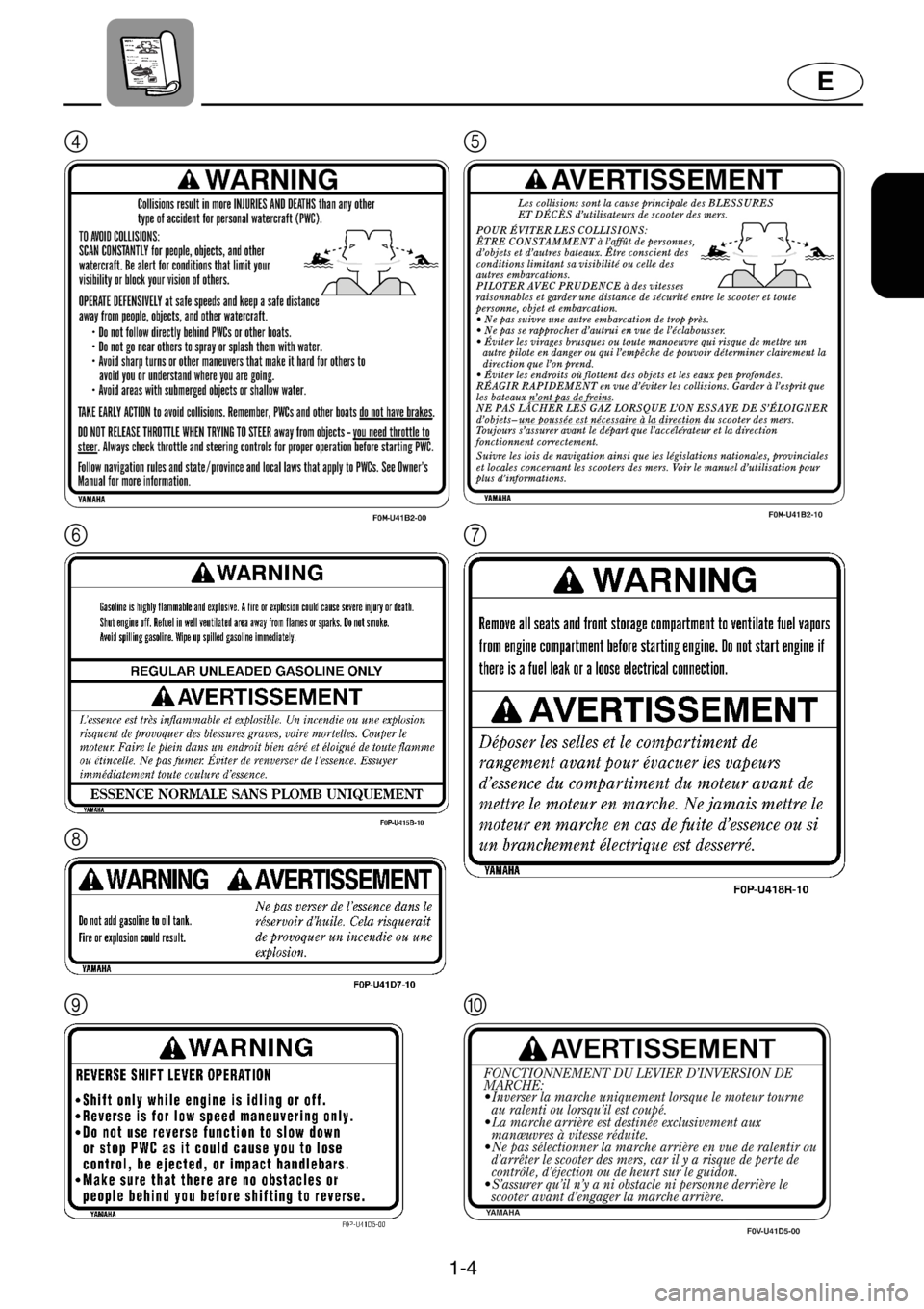
1-4
E
45
67
8
90
Page 12 of 131
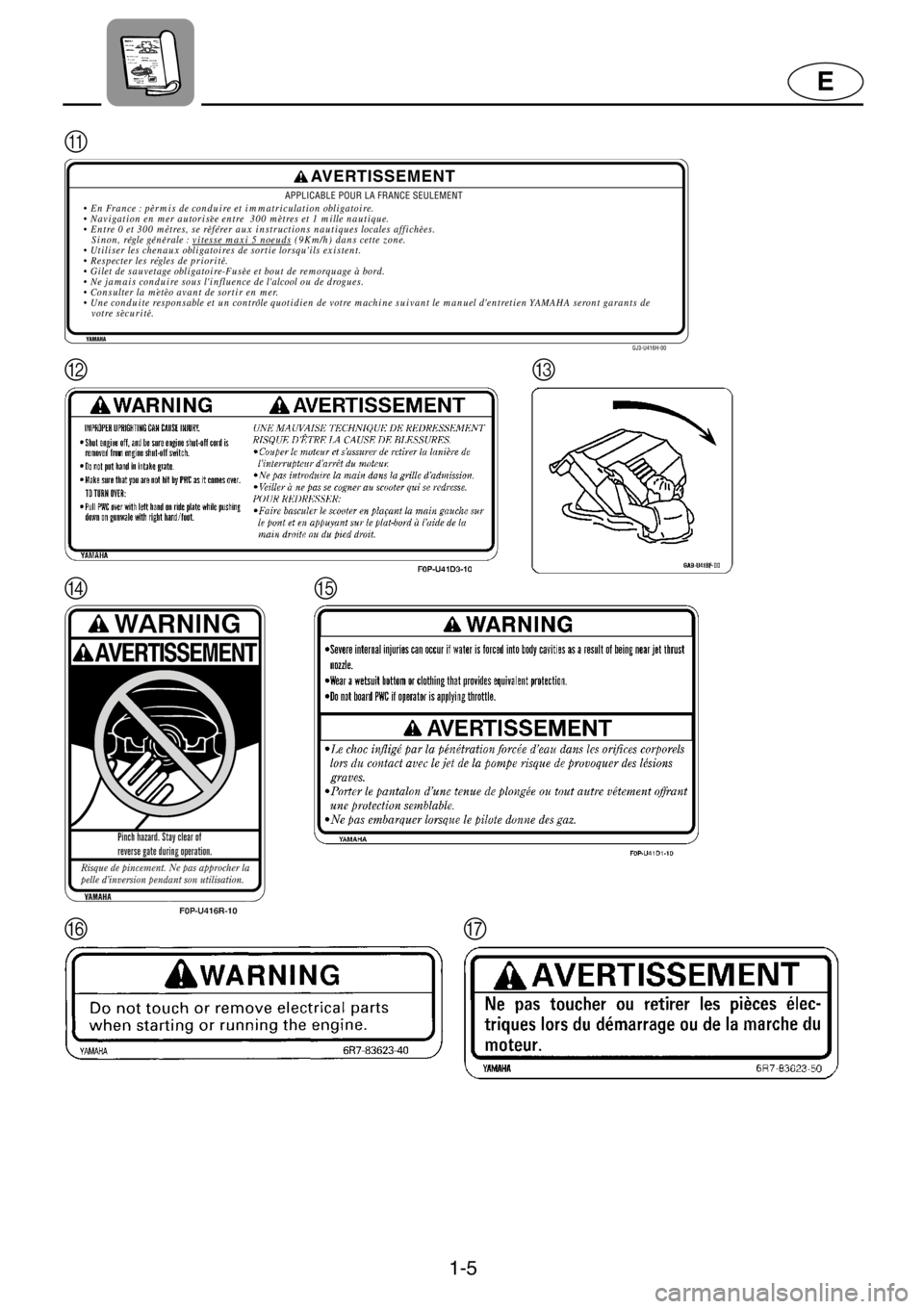
1-5
E
A
BC
DE
FG
Page 13 of 131
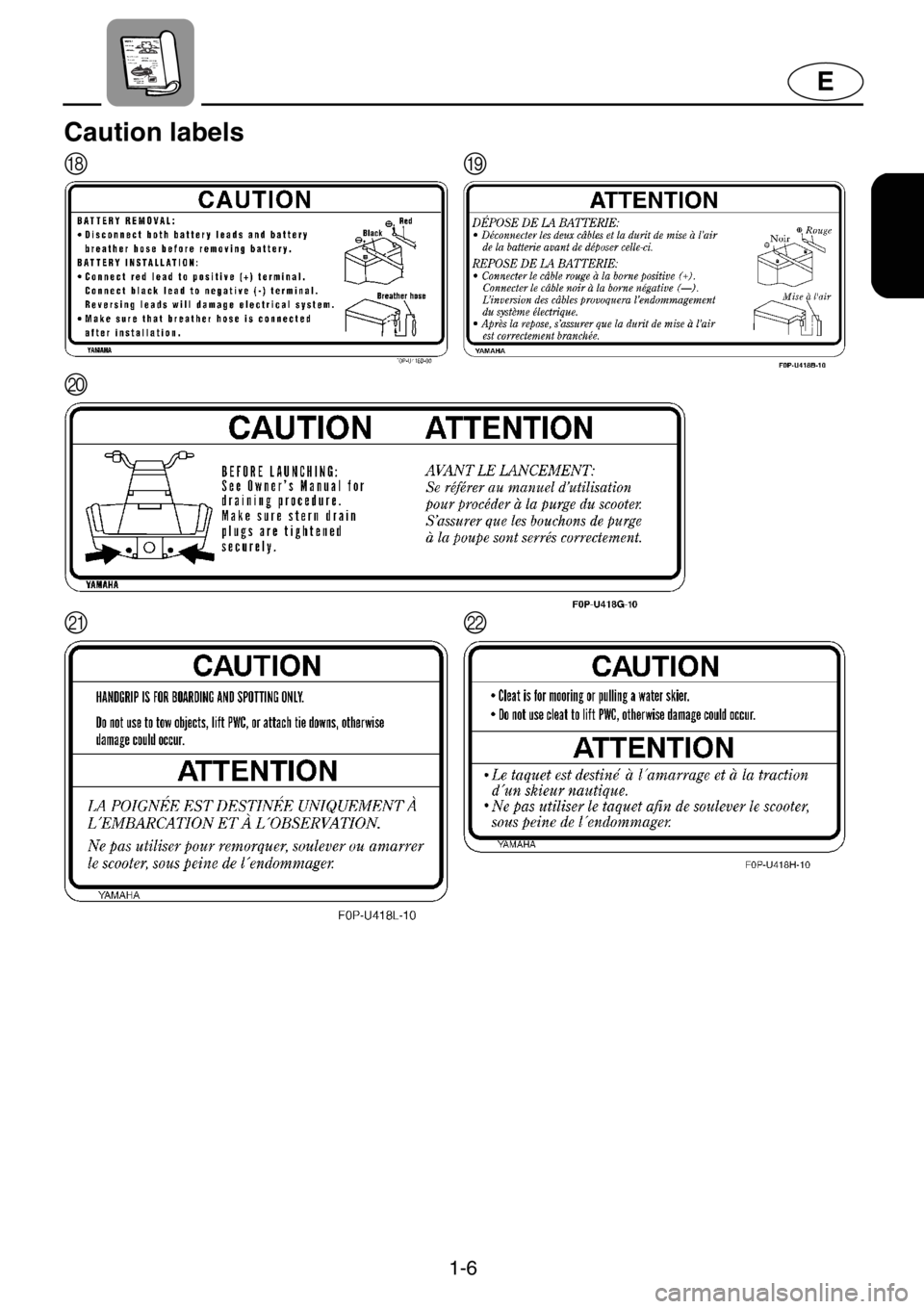
1-6
E
Caution labels
HI
J
KL
Page 14 of 131
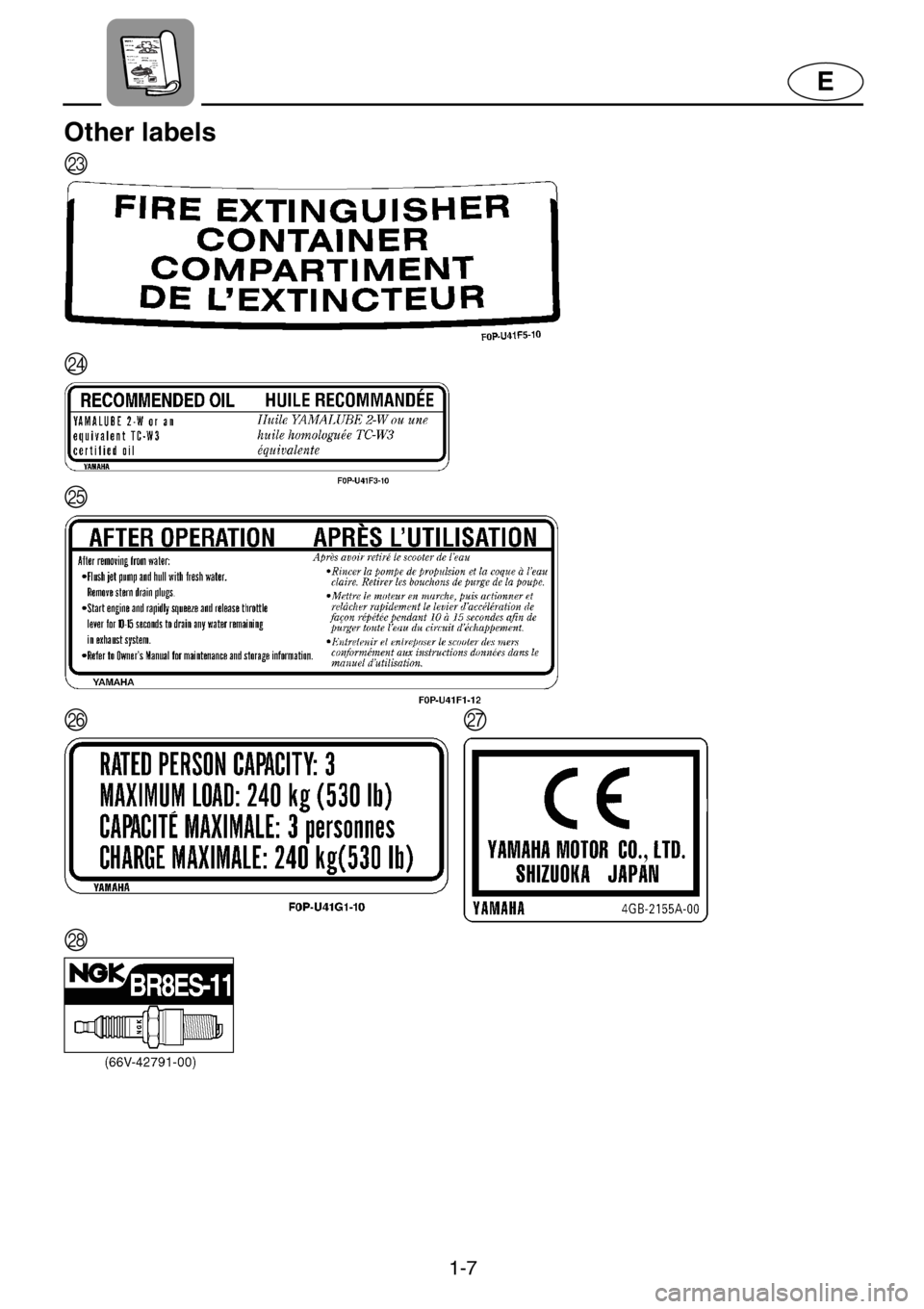
1-7
E
Other labels
M
N
O
PQ
R
Page 15 of 131
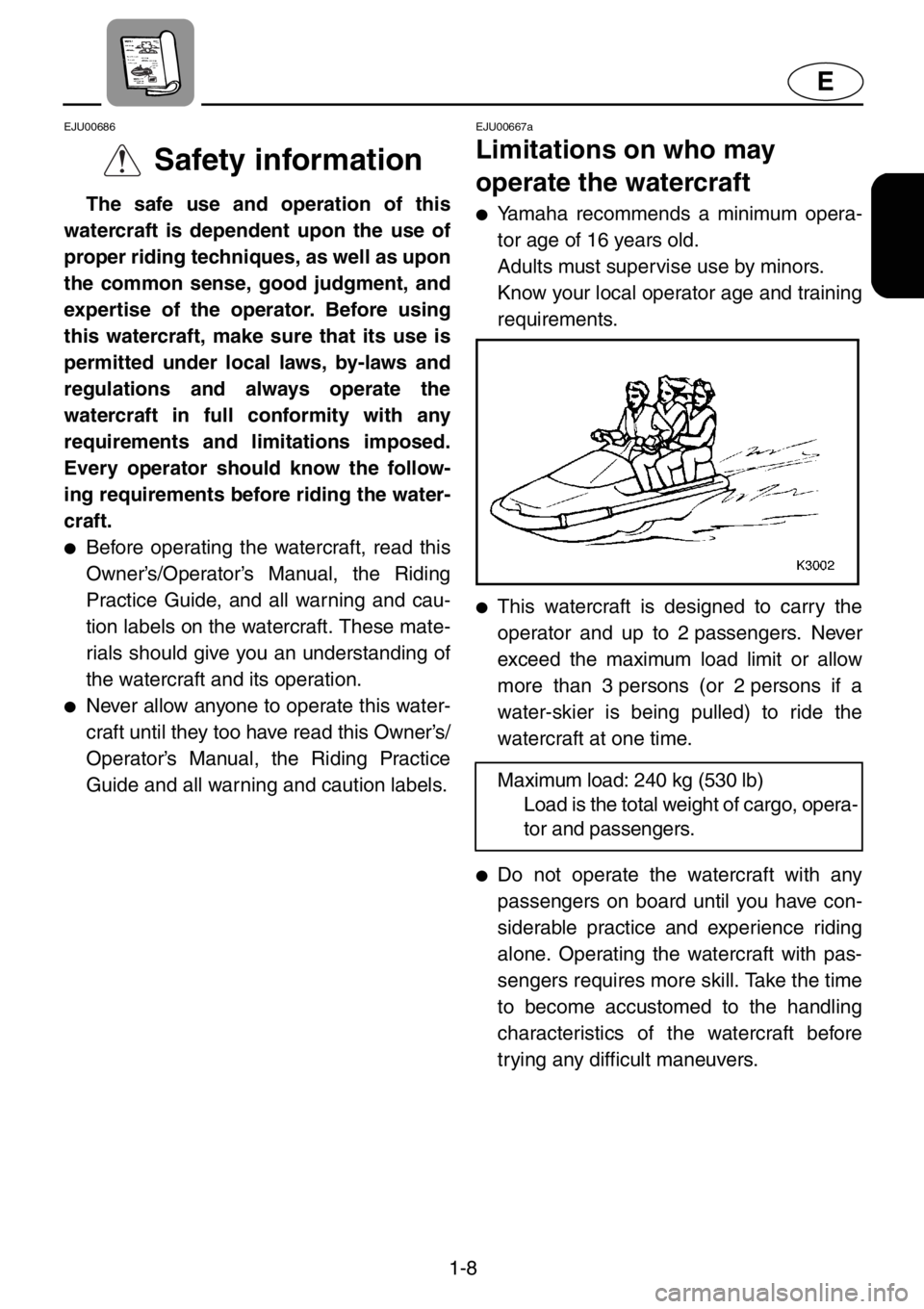
1-8
E
EJU00686
Safety information
The safe use and operation of this
watercraft is dependent upon the use of
proper riding techniques, as well as upon
the common sense, good judgment, and
expertise of the operator. Before using
this watercraft, make sure that its use is
permitted under local laws, by-laws and
regulations and always operate the
watercraft in full conformity with any
requirements and limitations imposed.
Every operator should know the follow-
ing requirements before riding the water-
craft.
●Before operating the watercraft, read this
Owner’s/Operator’s Manual, the Riding
Practice Guide, and all warning and cau-
tion labels on the watercraft. These mate-
rials should give you an understanding of
the watercraft and its operation.
●Never allow anyone to operate this water-
craft until they too have read this Owner’s/
Operator’s Manual, the Riding Practice
Guide and all warning and caution labels.
EJU00667a
Limitations on who may
operate the watercraft
●Yamaha recommends a minimum opera-
tor age of 16 years old.
Adults must supervise use by minors.
Know your local operator age and training
requirements.
●This watercraft is designed to carry the
operator and up to 2 passengers. Never
exceed the maximum load limit or allow
more than 3 persons (or 2 persons if a
water-skier is being pulled) to ride the
watercraft at one time.
●Do not operate the watercraft with any
passengers on board until you have con-
siderable practice and experience riding
alone. Operating the watercraft with pas-
sengers requires more skill. Take the time
to become accustomed to the handling
characteristics of the watercraft before
trying any difficult maneuvers.
Maximum load: 240 kg (530 lb)
Load is the total weight of cargo, opera-
tor and passengers.
Page 16 of 131
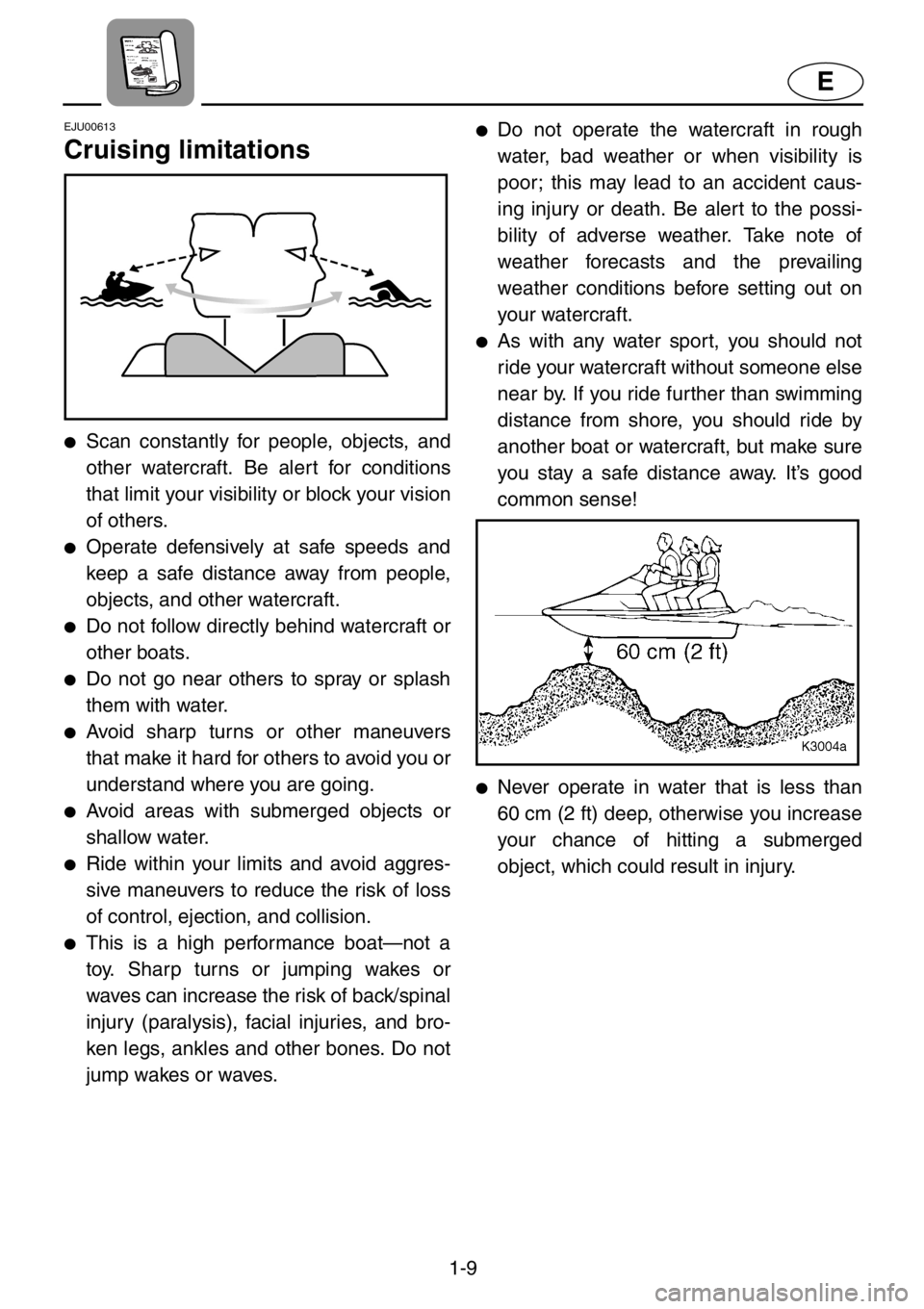
1-9
E
EJU00613
Cruising limitations
●Scan constantly for people, objects, and
other watercraft. Be alert for conditions
that limit your visibility or block your vision
of others.
●Operate defensively at safe speeds and
keep a safe distance away from people,
objects, and other watercraft.
●Do not follow directly behind watercraft or
other boats.
●Do not go near others to spray or splash
them with water.
●Avoid sharp turns or other maneuvers
that make it hard for others to avoid you or
understand where you are going.
●Avoid areas with submerged objects or
shallow water.
●Ride within your limits and avoid aggres-
sive maneuvers to reduce the risk of loss
of control, ejection, and collision.
●This is a high performance boat—not a
toy. Sharp turns or jumping wakes or
waves can increase the risk of back/spinal
injury (paralysis), facial injuries, and bro-
ken legs, ankles and other bones. Do not
jump wakes or waves.
●Do not operate the watercraft in rough
water, bad weather or when visibility is
poor; this may lead to an accident caus-
ing injury or death. Be alert to the possi-
bility of adverse weather. Take note of
weather forecasts and the prevailing
weather conditions before setting out on
your watercraft.
●As with any water sport, you should not
ride your watercraft without someone else
near by. If you ride further than swimming
distance from shore, you should ride by
another boat or watercraft, but make sure
you stay a safe distance away. It’s good
common sense!
●Never operate in water that is less than
60 cm (2 ft) deep, otherwise you increase
your chance of hitting a submerged
object, which could result in injury.
Page 17 of 131
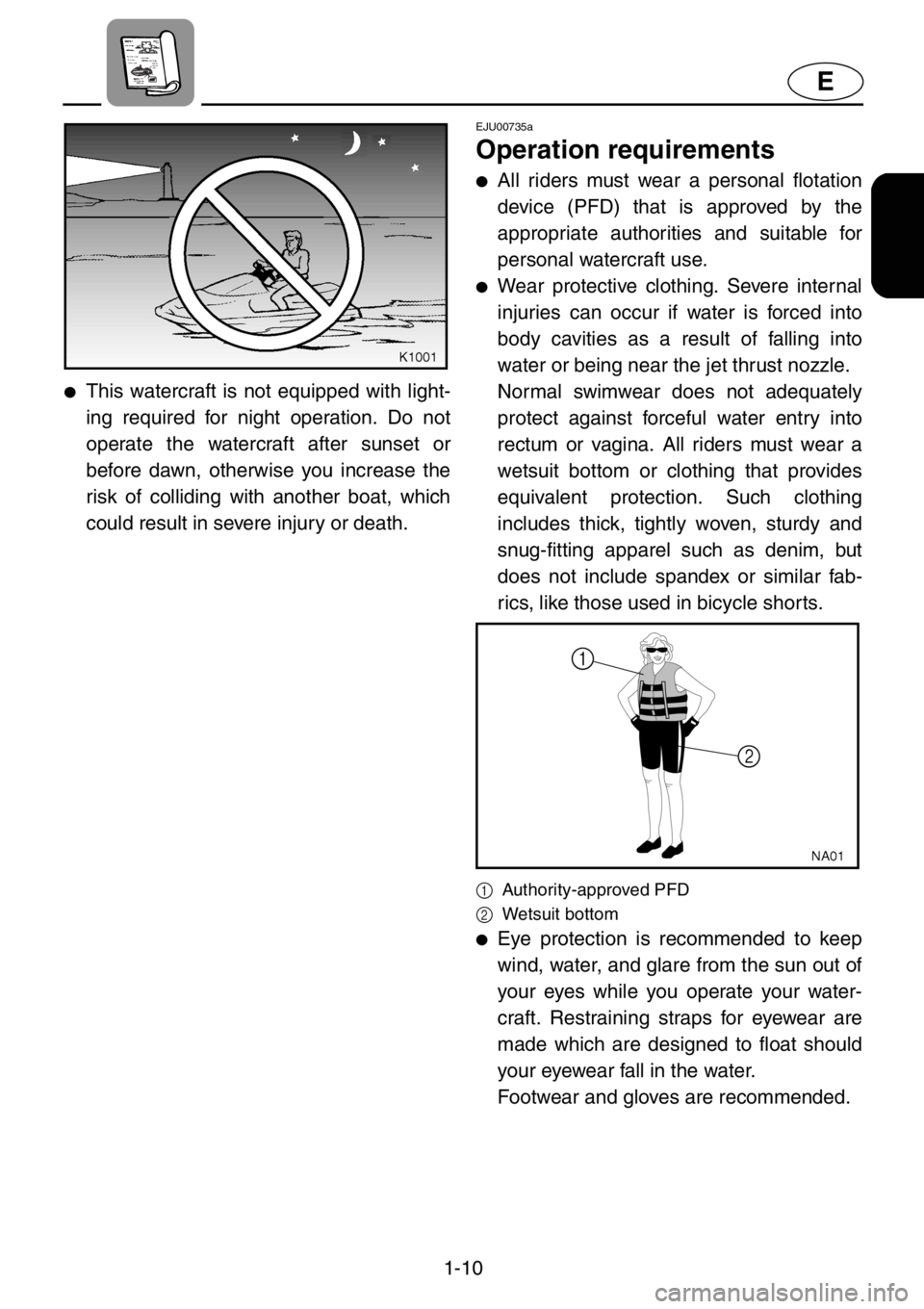
1-10
E
●This watercraft is not equipped with light-
ing required for night operation. Do not
operate the watercraft after sunset or
before dawn, otherwise you increase the
risk of colliding with another boat, which
could result in severe injury or death.
EJU00735a
Operation requirements
●All riders must wear a personal flotation
device (PFD) that is approved by the
appropriate authorities and suitable for
personal watercraft use.
●Wear protective clothing. Severe internal
injuries can occur if water is forced into
body cavities as a result of falling into
water or being near the jet thrust nozzle.
Normal swimwear does not adequately
protect against forceful water entry into
rectum or vagina. All riders must wear a
wetsuit bottom or clothing that provides
equivalent protection. Such clothing
includes thick, tightly woven, sturdy and
snug-fitting apparel such as denim, but
does not include spandex or similar fab-
rics, like those used in bicycle shorts.
1
Authority-approved PFD
2
Wetsuit bottom
●Eye protection is recommended to keep
wind, water, and glare from the sun out of
your eyes while you operate your water-
craft. Restraining straps for eyewear are
made which are designed to float should
your eyewear fall in the water.
Footwear and gloves are recommended.
Page 18 of 131
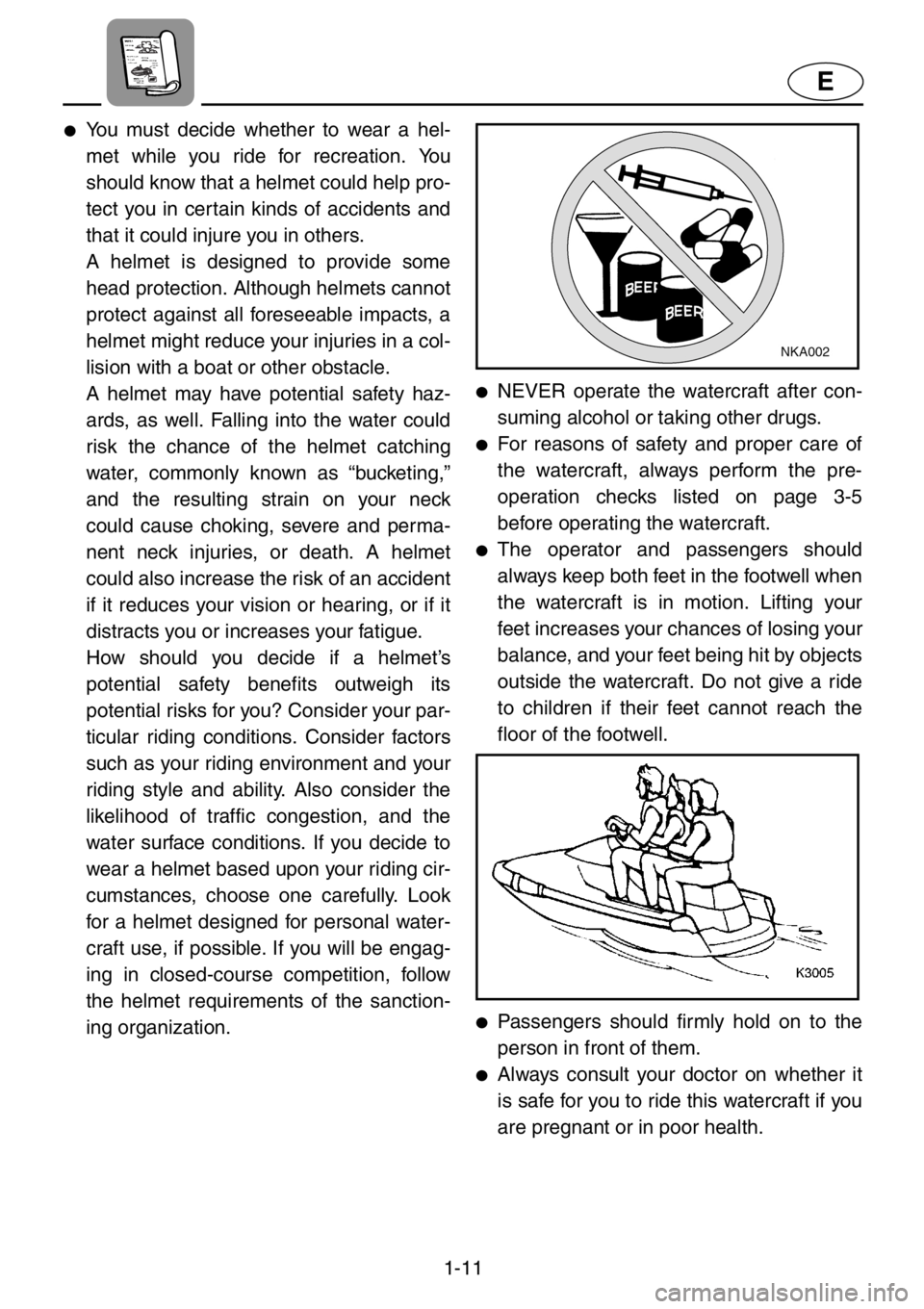
1-11
E
●You must decide whether to wear a hel-
met while you ride for recreation. You
should know that a helmet could help pro-
tect you in certain kinds of accidents and
that it could injure you in others.
A helmet is designed to provide some
head protection. Although helmets cannot
protect against all foreseeable impacts, a
helmet might reduce your injuries in a col-
lision with a boat or other obstacle.
A helmet may have potential safety haz-
ards, as well. Falling into the water could
risk the chance of the helmet catching
water, commonly known as “bucketing,”
and the resulting strain on your neck
could cause choking, severe and perma-
nent neck injuries, or death. A helmet
could also increase the risk of an accident
if it reduces your vision or hearing, or if it
distracts you or increases your fatigue.
How should you decide if a helmet’s
potential safety benefits outweigh its
potential risks for you? Consider your par-
ticular riding conditions. Consider factors
such as your riding environment and your
riding style and ability. Also consider the
likelihood of traffic congestion, and the
water surface conditions. If you decide to
wear a helmet based upon your riding cir-
cumstances, choose one carefully. Look
for a helmet designed for personal water-
craft use, if possible. If you will be engag-
ing in closed-course competition, follow
the helmet requirements of the sanction-
ing organization.
●NEVER operate the watercraft after con-
suming alcohol or taking other drugs.
●For reasons of safety and proper care of
the watercraft, always perform the pre-
operation checks listed on page 3-5
before operating the watercraft.
●The operator and passengers should
always keep both feet in the footwell when
the watercraft is in motion. Lifting your
feet increases your chances of losing your
balance, and your feet being hit by objects
outside the watercraft. Do not give a ride
to children if their feet cannot reach the
floor of the footwell.
●Passengers should firmly hold on to the
person in front of them.
●Always consult your doctor on whether it
is safe for you to ride this watercraft if you
are pregnant or in poor health.
Page 19 of 131
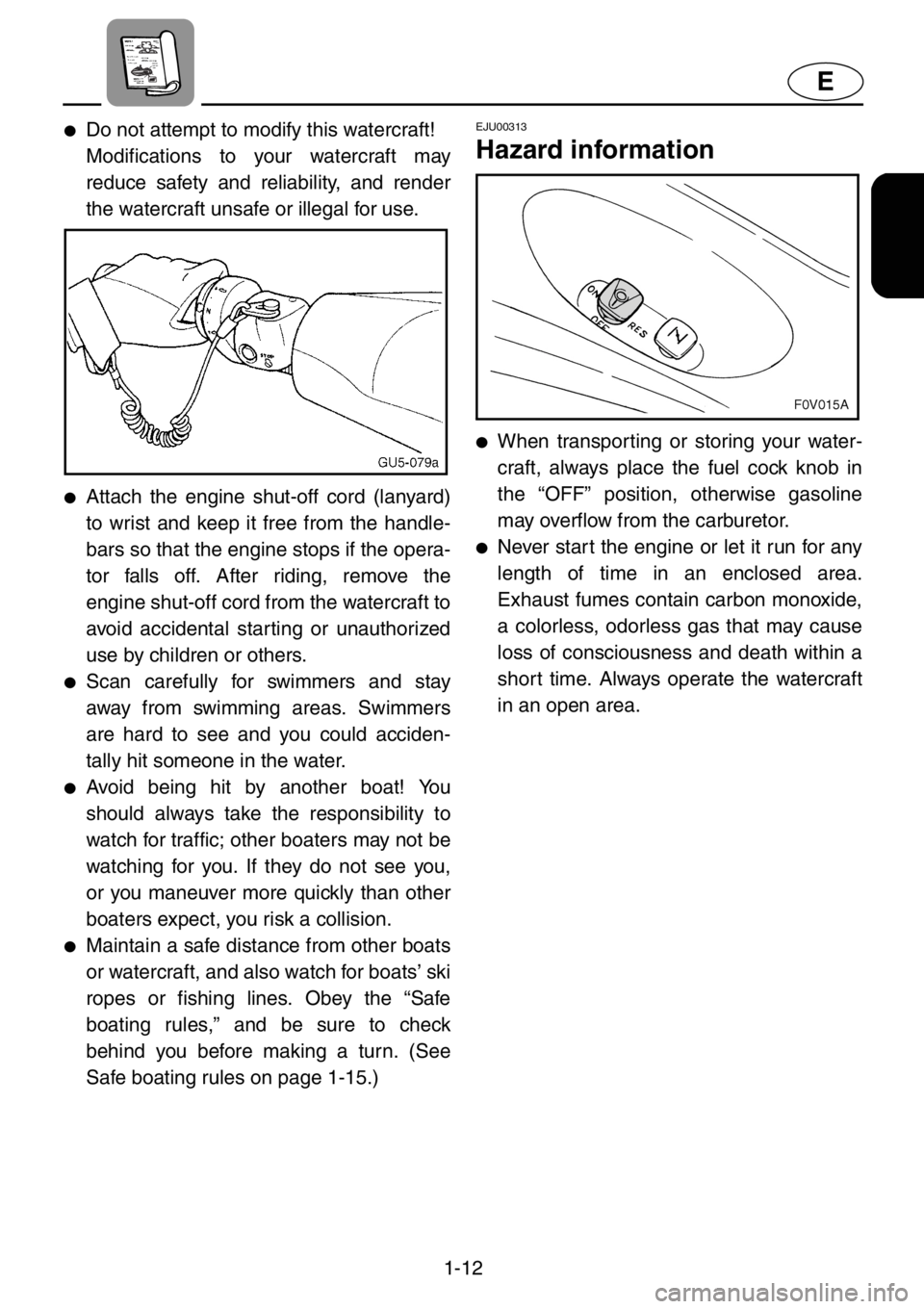
1-12
E
●Do not attempt to modify this watercraft!
Modifications to your watercraft may
reduce safety and reliability, and render
the watercraft unsafe or illegal for use.
●Attach the engine shut-off cord (lanyard)
to wrist and keep it free from the handle-
bars so that the engine stops if the opera-
tor falls off. After riding, remove the
engine shut-off cord from the watercraft to
avoid accidental starting or unauthorized
use by children or others.
●Scan carefully for swimmers and stay
away from swimming areas. Swimmers
are hard to see and you could acciden-
tally hit someone in the water.
●Avoid being hit by another boat! You
should always take the responsibility to
watch for traffic; other boaters may not be
watching for you. If they do not see you,
or you maneuver more quickly than other
boaters expect, you risk a collision.
●Maintain a safe distance from other boats
or watercraft, and also watch for boats’ ski
ropes or fishing lines. Obey the “Safe
boating rules,” and be sure to check
behind you before making a turn. (See
Safe boating rules on page 1-15.)
EJU00313
Hazard information
●When transporting or storing your water-
craft, always place the fuel cock knob in
the “OFF” position, otherwise gasoline
may overflow from the carburetor.
●Never start the engine or let it run for any
length of time in an enclosed area.
Exhaust fumes contain carbon monoxide,
a colorless, odorless gas that may cause
loss of consciousness and death within a
short time. Always operate the watercraft
in an open area.
Page 20 of 131
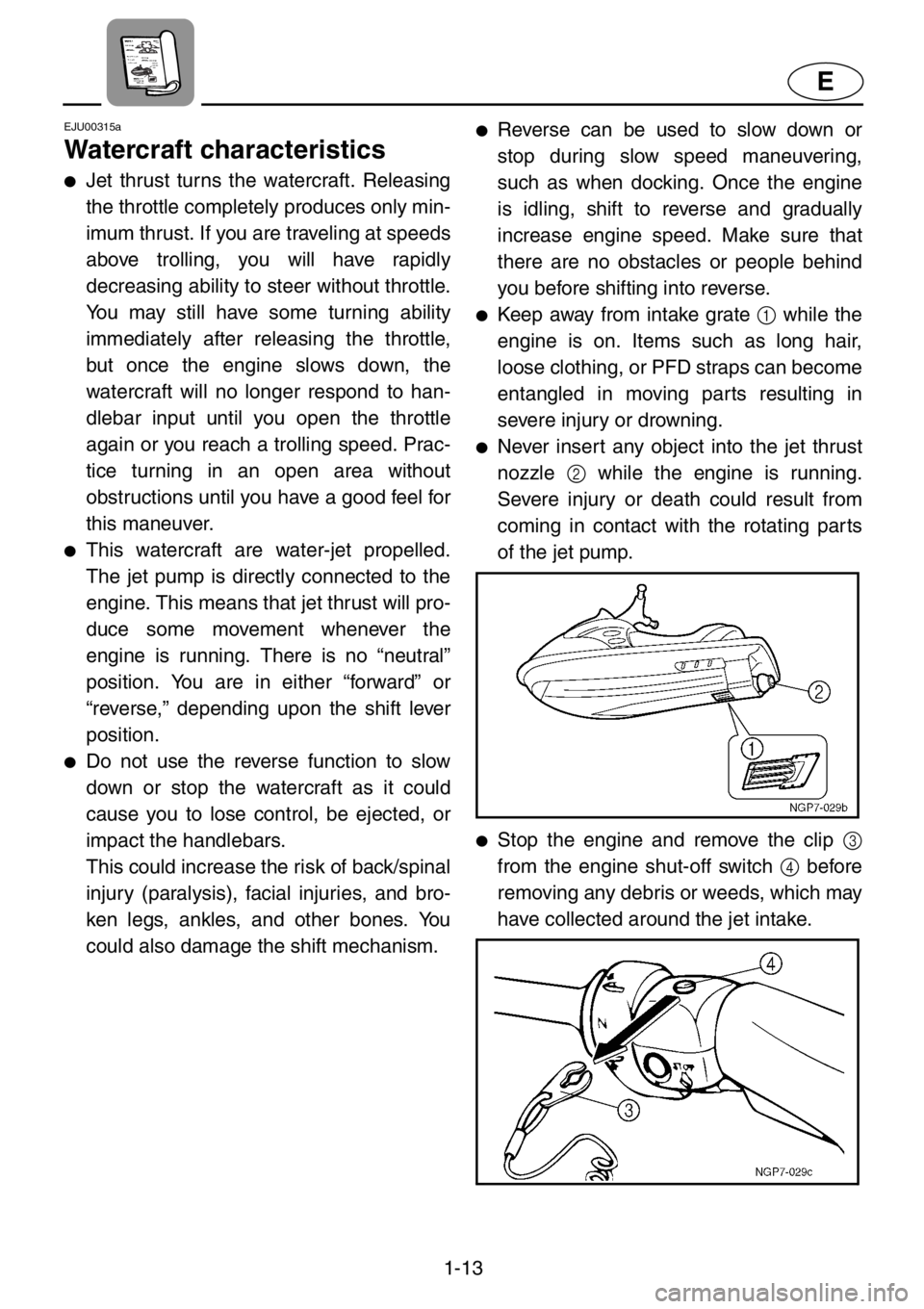
1-13
E
EJU00315a
Watercraft characteristics
●Jet thrust turns the watercraft. Releasing
the throttle completely produces only min-
imum thrust. If you are traveling at speeds
above trolling, you will have rapidly
decreasing ability to steer without throttle.
You may still have some turning ability
immediately after releasing the throttle,
but once the engine slows down, the
watercraft will no longer respond to han-
dlebar input until you open the throttle
again or you reach a trolling speed. Prac-
tice turning in an open area without
obstructions until you have a good feel for
this maneuver.
●This watercraft are water-jet propelled.
The jet pump is directly connected to the
engine. This means that jet thrust will pro-
duce some movement whenever the
engine is running. There is no “neutral”
position. You are in either “forward” or
“reverse,” depending upon the shift lever
position.
●Do not use the reverse function to slow
down or stop the watercraft as it could
cause you to lose control, be ejected, or
impact the handlebars.
This could increase the risk of back/spinal
injury (paralysis), facial injuries, and bro-
ken legs, ankles, and other bones. You
could also damage the shift mechanism.
●Reverse can be used to slow down or
stop during slow speed maneuvering,
such as when docking. Once the engine
is idling, shift to reverse and gradually
increase engine speed. Make sure that
there are no obstacles or people behind
you before shifting into reverse.
●Keep away from intake grate 1 while the
engine is on. Items such as long hair,
loose clothing, or PFD straps can become
entangled in moving parts resulting in
severe injury or drowning.
●Never insert any object into the jet thrust
nozzle 2 while the engine is running.
Severe injury or death could result from
coming in contact with the rotating parts
of the jet pump.
●Stop the engine and remove the clip 3
from the engine shut-off switch 4 before
removing any debris or weeds, which may
have collected around the jet intake.